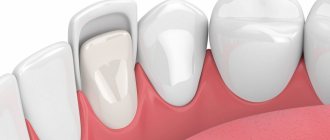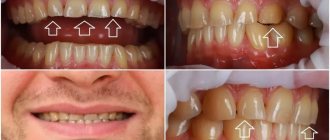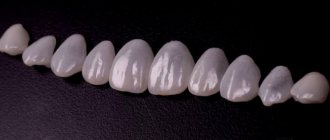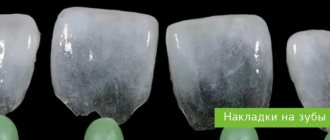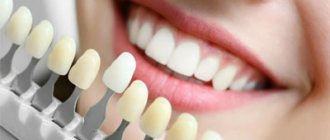Once upon a time, our ancestors made dishes from ceramics, but today they can be used to make the thinnest plates that can turn a smile into a real work of art. We are talking about installing ceramic veneers, with the help of which it is possible to give teeth an ideal shape and aesthetic shade, while preserving their natural transparent structure. Magomed Umatgireevich Dakhkilgov, chief physician of the GERMAN IMPLANTOLOGY CENTER, told us about all the nuances of the unique procedure.
What are porcelain veneers?
A ceramic veneer is a thin plate of high-quality ceramics approximately 0.3 - 0.5 millimeters thick. The microprosthesis is fixed to the external tooth surface using special cement. Veneers correct the color, shape and slight curvature of teeth, trema and diastema, as well as crowding.
Photos before and after installation of ceramic veneers at the Research Center. Works by Avetisyan R.A., Dakhkilgov M.U., and Karneev A.N.
What are the disadvantages of veneers that need to be taken into account?
The main disadvantage is that they cannot be removed by yourself or even dismantled without damaging them. These are not braces. Well, the enamel needs to be prepared - yes, in a thin layer, only 0.5-0.7 mm, but even such an impact can bring negative consequences. Protection against pathogens, aggressive environments, mechanical and chemical factors deteriorates.
As a result, you cannot simply remove the plates - after this you need to either attach new ones or use some other method of restoring the beauty of your smile.
Existing pathologies should also be taken into account. In severe cases, microprostheses can provoke a change in diction. Another disadvantage of veneers lies in the fact that the teeth protruding from under them will still be stained and darken, which means that over time they will become different in color, at least on the inside. To prevent this aesthetic problem, you need to change your menu and stop smoking. Although giving up bad habits is, in principle, a sound idea, even if everything is fine with a smile.
These overlays must be fixed by a specialist, because in case of non-compliance with the technology or errors, the following unpleasant consequences are possible:
- Loose fit and, as a result, darkening of the plate.
- Protruding edges that can cause injury to the soft tissues of the oral cavity.
- A manifestation of hypersensitivity, indicating either poor enamel cleaning or the development of caries.
In addition, you can break off a piece of such a microprosthesis if you thoughtlessly bite into too hard food.
Advantages of ceramic veneers over composite ones
Unlike composite ones, the advantages of ceramic onlays are obvious to any specialist. And here's why: even the most expensive composite is actually plastic; it quickly loses its shine, darkens and delaminates over time. This means that composite veneers are less durable and aesthetically pleasing. Ceramic veneers, on the contrary, cannot be stained, do not change their shape, retain their relief and have the shine of natural teeth. All this makes restorations an excellent tool for creating an ideal smile, without which modern aesthetic dentistry is unthinkable. The only disadvantages of ceramic veneers are the price and complexity of installation, which require the patient to carefully approach the choice of a dental clinic.
How is a ceramic veneer different from a lumineer?
By and large, Lumineers are the same ceramic veneers, but more matte, less able to convey the transparency and shine of the enamel, which, in my opinion, leads to a less aesthetic result. The statement that there is no need to prepare before placing lumineers on the teeth is also incorrect. Therefore, I personally do not see the point in lumineing, the quality of which does not suit me, and I prefer to work with classic ceramic veneers.
Contraindications
- In addition to extensive caries and multiple fillings, until recently, pulpless teeth were also included in the list of contraindications for veneering. However, today many orthopedic doctors do not consider this an obstacle to installing veneers.
- Bruxism, as well as problems with bite, must be eliminated before the procedure.
- People who do not follow basic rules of oral hygiene should not think about getting veneers.
- Is it possible to install veneers if the bite is incorrect? Most likely not, but the final decision must be made by the doctor. If there are problems with the bite, incorrect prosthetics can lead to breakdown of the structure and disruption of the lower temporomandibular joint.
Types of restorations with ceramic veneers
There are two types of porcelain veneers: pressed porcelain and porcelain-fabricated porcelain veneers. Initially, there are no special differences between the two types. The quality of structures is determined by further processing and installation.
Made from pressed ceramic
To create pressed porcelain veneers, wax modeling is first used. A model is created from special wax, according to which a ceramic plate is pressed under high pressure. On the front side of the plate, any anatomical features of the patient’s enamel are recreated. This method is good for accurately conveying the internal surface of the structure adjacent to the tooth.
Manufacturing on a refractor
When making a ceramic veneer using a refractor, special stumps are first created from a refractory mass, and then the ceramic mass is applied to them in layers. The finished structure is subsequently baked in a special oven.
Both types of ceramic veneers are offered. Regardless of the manufacturing method, ceramic onlays are always strictly individualized for the patient and installed at the highest level.
How long do veneers last?
Based on the material from which they are made, linings are divided into ceramic
and
composite
. The first ones are made from impressions in a dental laboratory, and the second ones are made directly in the dentist’s chair. The quality of the material is completely different and the fracture toughness of different types of linings differs significantly. But it is this that determines the service life.
Contraindications for ceramic veneers
Ceramic veneers can be placed on teeth from the moment when the permanent bite is fully formed, that is, for patients over 18 years of age. However, the decision to undergo veneering should always be balanced and deliberate. The general list of contraindications is as follows:
- Large fillings on front teeth
- Extensive carious lesions
- Gingivitis
- Periodontitis
- Malocclusions
Indications for installation
Veneers are used for a variety of purposes, but all patients expect the opportunity to have a dazzling smile without worrying about the unaesthetic appearance of their natural teeth. Dentists recommend the use of veneers in the following cases:
- Persistent staining of tooth enamel that cannot be whitened in people who smoke and often eat foods with coloring pigments.
- Presence of fluorescent spots. Old fillings placed on the anterior labial surface that have changed color.
- Rough edges, cracked or chipped teeth due to trauma, various types of mechanical damage. In these cases, therapeutic veneers are made.
- Crowding of the front teeth. Slight irregularities, too narrow, large or short teeth.
- Diastemas and tremas are spaces between teeth in different places of the upper and lower dentition.
- Brittle teeth and increased sensitivity to hot and cold foods.
- The patient’s desire to restore worn teeth in the most gentle way.
Often, veneers are made for 6-8 front teeth, and the rest are whitened or prepared for the installation of a bridge or implants. It is important to remember that the use of artificial plates is only a cosmetic technique, before which it is necessary to undergo treatment for caries and other inflammatory diseases of the oral cavity.
Installation of ceramic veneers
Ceramic veneers are not “seated” onto the tooth using cement, like a filling. Fixing a thin ceramic plate is a complex process. Here it is necessary to follow a clear sequence of actions: first you need to etch the veneer, then wash it with a special solution, then apply a special substance to it, etc. Only by following a clear procedure can you ensure a high-tech installation of a ceramic veneer, in which adhesion between it and the tooth happens at the chemical level. The structure should not just stick to the tooth surface, but practically fuse with it. As for the sequence of actions in a broader sense, it all starts with consultation.
- Consultation
. First of all, it becomes clear what the nature of the problem that a person wants to solve with the help of veneering is. Here, first of all, attention is paid to the bite. If the defect is in the frontal region and is associated with orthodontics, orthodontic treatment with braces or mouthguards to straighten the teeth is first suggested.
- Fitting
. Next, an impression is made, from which diagnostic models are made. Then, using a silicone key (mock-up technology), the desired changes are transferred to the oral cavity. A special composite is inserted into the key and the expected result of future veneering is “squeezed” onto the teeth. Thus, the patient “tryes on” ceramic veneers on his teeth in advance. This model is quite conventional; a real ceramic veneer looks much better, but a person gets a general idea: he sees exactly how the shape of teeth and even their color can be changed.
- Dental treatment.
When the future parameters of the veneers are approved, using special marking burs, the teeth are prepared directly through the composite of the temporary structures. Excessive grinding of natural teeth is avoided; the doctor acts exclusively within the enamel, and in some places even it is not affected.
- Casts
. After preparation, impressions are taken. Temporary structures are then placed on the teeth.
- Creation and installation.
The production of ceramic veneers ranges from a week to three. The finished onlays are tried on and, if the patient has no complaints, they are fixed on the teeth.
Nanoneers
Nanoneers
There is a misconception that nanoeers are a new generation of American lumineers. This is not entirely true.
This veneer design is created in Russian clinics, but from material and technology developed in Switzerland. The ceramics used to make nanoirs contain nanoparticles, which significantly improves the quality of the material.
The similarity with lumineers is that the abutment tooth is not ground down before installation. However, after the onlay is fixed, it must be polished and adjusted to the size of the tooth.
The advantage of this type of overlay is that they are cheaper than ultraneers and lumineers. But at the same time they are not so durable and aesthetically pleasing. In Russia, such prostheses are installed only in some clinics.
Is it always possible to get veneers?
Installation of veneers and lumineers is carried out only on healthy teeth. Therefore, before installing any type of onlays, the patient needs to visit the dentist’s office and undergo a full examination of the oral cavity - to cure caries and get rid of possible problems with the gums. This is necessary so that in the future, when installing veneers, no problems arise, and they do not have to be removed ahead of time.
It must be remembered that, like any medical procedure, the installation of veneers has contraindications:
- the presence of a pronounced malocclusion, which must first be corrected with braces or any other removable denture;
- bruxism - involuntary “grinding” of teeth, which can destroy even a durable denture;
- the absence of more than 50% of the tooth or the presence of a large filling on the surface of the tooth, which will make it difficult to securely fix the onlay on the tooth;
- lack of chewing teeth;
- pathological abrasion of teeth;
- periodontal disease.
As you can see, many contraindications are relative - they, one way or another, can be eliminated by the dentist, after which veneers can be installed.
To avoid any unpleasant moments in connection with the installation of veneers and to make your smile shine again and bring you joy, you need to contact only professionals.
Before and after installation of 4 veneers on the upper teeth at the Research Center
Make an appointment
right now!
Dakhkilgov Magomed Umatgireevich
Surgeon, Implantologist
Ceramic veneers without turning
Some doctors are disingenuous when they say that the installation of composite veneers, unlike ceramic ones, requires virtually no preparation. In fact, it is impossible to install composite or ceramic veneers without grinding. However, the higher the quality of the specialist’s work, the less impact there is on the teeth. The teeth are processed only with the help of high-quality German burs, precisely centered and having a strictly specified grain size. Moreover, the installation of ceramic veneers is carried out using a high-tech dental microscope. Thus, through the use of modern technologies and materials, we are able to achieve minimal, but very high-quality tooth processing, literally within the enamel. Thanks to this innovative approach, the plate fits perfectly to the prepared surface, which significantly increases the service life of ceramic veneers.
Ultraneers
Ultraneers
They appeared relatively recently and serve as a good alternative to American lumineers. This type of onlay was developed in Russia based on patented ceramics of the IPS E. MAX brand.
Using modern technologies, pressed ceramics are produced from which ultra-thin plates are created - ultraneers.
Pros of ultra training:
- high aesthetics - the color of the lining can be matched exactly to the natural shade of the patient’s teeth;
- It can also be installed on sensitive teeth, since the grinding of the supporting tooth is minimal or not done at all;
- strength is 40% higher than that of ceramic veneers;
- since this is a completely Russian development, the cost does not depend on currency fluctuations and is therefore lower than the cost of lumineers;
- no need to wait several months before installation, since the product is manufactured in Russia;
- service life is about 15 years.
A significant disadvantage of ultranir is their high cost. They are 2 times more expensive than veneers, although they are produced in Russia. However, the cost of ultraneers is 30-40% lower than the cost of American lumineers.
